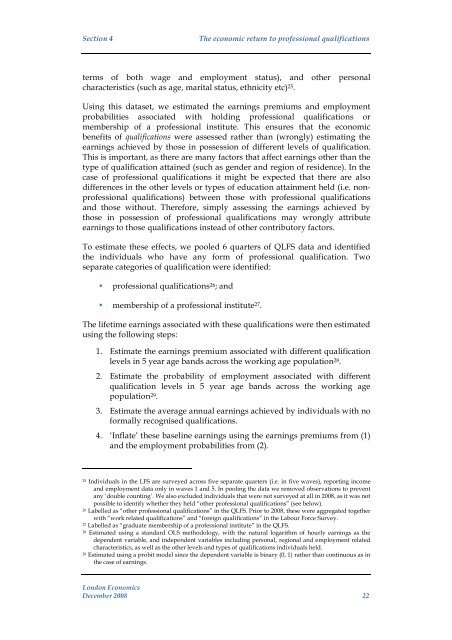Economic impact assessment of the CCPMO: Final report - CIPD
Economic impact assessment of the CCPMO: Final report - CIPD
Economic impact assessment of the CCPMO: Final report - CIPD
Create successful ePaper yourself
Turn your PDF publications into a flip-book with our unique Google optimized e-Paper software.
Section 4<br />
The economic return to pr<strong>of</strong>essional qualifications<br />
terms <strong>of</strong> both wage and employment status), and o<strong>the</strong>r personal<br />
characteristics (such as age, marital status, ethnicity etc) 25 .<br />
Using this dataset, we estimated <strong>the</strong> earnings premiums and employment<br />
probabilities associated with holding pr<strong>of</strong>essional qualifications or<br />
membership <strong>of</strong> a pr<strong>of</strong>essional institute. This ensures that <strong>the</strong> economic<br />
benefits <strong>of</strong> qualifications were assessed ra<strong>the</strong>r than (wrongly) estimating <strong>the</strong><br />
earnings achieved by those in possession <strong>of</strong> different levels <strong>of</strong> qualification.<br />
This is important, as <strong>the</strong>re are many factors that affect earnings o<strong>the</strong>r than <strong>the</strong><br />
type <strong>of</strong> qualification attained (such as gender and region <strong>of</strong> residence). In <strong>the</strong><br />
case <strong>of</strong> pr<strong>of</strong>essional qualifications it might be expected that <strong>the</strong>re are also<br />
differences in <strong>the</strong> o<strong>the</strong>r levels or types <strong>of</strong> education attainment held (i.e. nonpr<strong>of</strong>essional<br />
qualifications) between those with pr<strong>of</strong>essional qualifications<br />
and those without. Therefore, simply assessing <strong>the</strong> earnings achieved by<br />
those in possession <strong>of</strong> pr<strong>of</strong>essional qualifications may wrongly attribute<br />
earnings to those qualifications instead <strong>of</strong> o<strong>the</strong>r contributory factors.<br />
To estimate <strong>the</strong>se effects, we pooled 6 quarters <strong>of</strong> QLFS data and identified<br />
<strong>the</strong> individuals who have any form <strong>of</strong> pr<strong>of</strong>essional qualification. Two<br />
separate categories <strong>of</strong> qualification were identified:<br />
<br />
pr<strong>of</strong>essional qualifications 26 ; and<br />
membership <strong>of</strong> a pr<strong>of</strong>essional institute 27 .<br />
The lifetime earnings associated with <strong>the</strong>se qualifications were <strong>the</strong>n estimated<br />
using <strong>the</strong> following steps:<br />
1. Estimate <strong>the</strong> earnings premium associated with different qualification<br />
levels in 5 year age bands across <strong>the</strong> working age population 28 .<br />
2. Estimate <strong>the</strong> probability <strong>of</strong> employment associated with different<br />
qualification levels in 5 year age bands across <strong>the</strong> working age<br />
population 29 .<br />
3. Estimate <strong>the</strong> average annual earnings achieved by individuals with no<br />
formally recognised qualifications.<br />
4. ‘Inflate’ <strong>the</strong>se baseline earnings using <strong>the</strong> earnings premiums from (1)<br />
and <strong>the</strong> employment probabilities from (2).<br />
25<br />
Individuals in <strong>the</strong> LFS are surveyed across five separate quarters (i.e. in five waves), <strong>report</strong>ing income<br />
and employment data only in waves 1 and 5. In pooling <strong>the</strong> data we removed observations to prevent<br />
any ‘double counting’. We also excluded individuals that were not surveyed at all in 2008, as it was not<br />
possible to identify whe<strong>the</strong>r <strong>the</strong>y held “o<strong>the</strong>r pr<strong>of</strong>essional qualifications” (see below).<br />
26 Labelled as “o<strong>the</strong>r pr<strong>of</strong>essional qualifications” in <strong>the</strong> QLFS. Prior to 2008, <strong>the</strong>se were aggregated toge<strong>the</strong>r<br />
with “work related qualifications” and “foreign qualifications” in <strong>the</strong> Labour Force Survey.<br />
27 Labelled as “graduate membership <strong>of</strong> a pr<strong>of</strong>essional institute” in <strong>the</strong> QLFS.<br />
28 Estimated using a standard OLS methodology, with <strong>the</strong> natural logarithm <strong>of</strong> hourly earnings as <strong>the</strong><br />
dependent variable, and independent variables including personal, regional and employment related<br />
characteristics, as well as <strong>the</strong> o<strong>the</strong>r levels and types <strong>of</strong> qualifications individuals held.<br />
29<br />
Estimated using a probit model since <strong>the</strong> dependent variable is binary (0, 1) ra<strong>the</strong>r than continuous as in<br />
<strong>the</strong> case <strong>of</strong> earnings.<br />
London <strong>Economic</strong>s<br />
December 2008 22

















